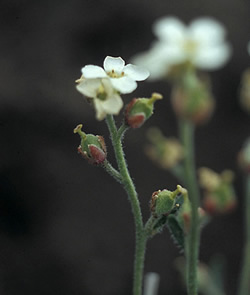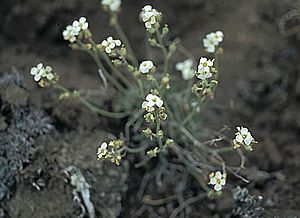Hairy braya facts for kids
Quick facts for kids Hairy braya |
|
|---|---|
 |
|
| Conservation status | |
| Scientific classification | |
| Genus: |
Braya
|
| Species: |
pilosa
|
Braya pilosa is a very special flowering plant. It is also known by its common name, the hairy braya. This plant is a perennial, which means it lives for many years. It belongs to the mustard family, just like the mustard plants you might know!
Contents
Discovering the Hairy Braya
The hairy braya is a unique plant. It has one or more stems that can grow from 4 to 12 centimeters long. These stems can stand up straight or spread out close to the ground. The plant is covered in many hairs, which is how it got its name.
What Does It Look Like?
The hairy braya grows from a bunch of leaves at its base. Its flowers are white and grow in tight groups. You can tell this plant apart from other Braya species because its flowers are quite large. It also has round fruits with very long, thin parts called styles.
Where Does It Live?
This plant is found in only a few places. It lives in parts of Cape Bathurst and the Baillie Islands. These areas are along the shore of the Beaufort Sea in the Northwest Territories of Canada. These specific spots were not covered by glaciers a long time ago.
Why Is It Endangered?
The hairy braya is a very rare plant. Experts at NatureServe say it is "imperiled," which means it is in great danger. The Committee on the Status of Endangered Wildlife in Canada (COSEWIC) also lists it as endangered. This means it is at high risk of disappearing forever.
What Are the Threats?
The main dangers to the hairy braya are:
- Habitat loss: Its home is shrinking because of fast coastal erosion. This is when the land along the coast wears away.
- Storm surges: Big waves from storms can bring salty water onto the land. This salty water can harm the plants.
- Melting permafrost: The ground in the Arctic is usually frozen all year round (called permafrost). When it melts, the land can become unstable, which hurts the plants.
Protecting the hairy braya is important. It helps keep the natural balance in its unique Arctic home.



